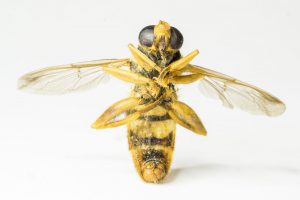Hoverflies, also known as flower flies or syrphid flies, are perhaps the most unrecognized and underappreciated pollinators. They are actually thought by some scientists to be the second most important group of pollinators after bees!
This is a large and relatively diverse group named for their behavior of hovering while in flight. They can also fly backwards, a rare characteristic in the insect world! As flies, they have the distinguishing features of a single pair of functional wings, unlike other insects such as bees and wasps that have two pairs of functional wings.

As adults, hoverflies visit flowers to drink nectar and consume pollen. However, unlike bees, they do not collect pollen to feed their young. Instead, while they are consuming pollen and nectar at the flower, they may accidentally get pollen on their bodies, which is then transferred to the next flowers that they visit.
In this way, they can act as pollinators. They do not have the specialized features for collecting and carrying pollen as bees do, but they are often abundant and frequent flower visitors, collectively playing a large role in plant pollination.
As larvae, they are predaceous on smaller insects, feeding primarily on aphids, and they are good pest control agents. Overall, between their predaceous larval stage and their pollinating adult stage, these flies are quite beneficial on farms and in gardens.
Since this is a large and diverse group, with approximately 6,000 species worldwide, they vary in appearance and size. They generally mimic bees or wasps and have yellow and black striping or spots. Some are quite small, many times smaller than honey bees, while others are as large as or larger than honey bees. They are found on all continents except Antarctica.
One of the more common hoverflies in Florida is Allograpta obliqua. This small syrphid can be found year-round in Florida, though in northern Florida, they are less common in the cooler months.
You can read more about this hoverfly on Featured Creatures.
 3
3
